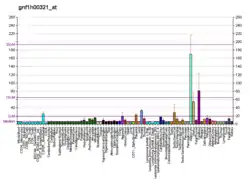PCDH18
Protocadherin-18 is a protein that in humans is encoded by the PCDH18 gene.[5][6][7]
| PCDH18 | |||||||||||||||||||||||||
|---|---|---|---|---|---|---|---|---|---|---|---|---|---|---|---|---|---|---|---|---|---|---|---|---|---|
| Identifiers | |||||||||||||||||||||||||
| Aliases | PCDH18, PCDH68L, protocadherin 18 | ||||||||||||||||||||||||
| External IDs | OMIM: 608287 MGI: 1920423 HomoloGene: 10389 GeneCards: PCDH18 | ||||||||||||||||||||||||
| |||||||||||||||||||||||||
| |||||||||||||||||||||||||
| |||||||||||||||||||||||||
| |||||||||||||||||||||||||
| Orthologs | |||||||||||||||||||||||||
| Species | Human | Mouse | |||||||||||||||||||||||
| Entrez | |||||||||||||||||||||||||
| Ensembl | |||||||||||||||||||||||||
| UniProt | |||||||||||||||||||||||||
| RefSeq (mRNA) | |||||||||||||||||||||||||
| RefSeq (protein) | |||||||||||||||||||||||||
| Location (UCSC) | Chr 4: 137.52 – 137.53 Mb | Chr 3: 49.74 – 49.76 Mb | |||||||||||||||||||||||
| PubMed search | [3] | [4] | |||||||||||||||||||||||
| Wikidata | |||||||||||||||||||||||||
| |||||||||||||||||||||||||
This gene belongs to the protocadherin gene family, a subfamily of the cadherin superfamily. This gene encodes a protein which contains 6 extracellular cadherin domains, a transmembrane domain and a cytoplasmic tail differing from those of the classical cadherins. Although its specific function is undetermined, the cadherin-related neuronal receptor is thought to play a role in the establishment and function of specific cell-cell connections in the brain.[7]
References
- GRCh38: Ensembl release 89: ENSG00000189184 - Ensembl, May 2017
- GRCm38: Ensembl release 89: ENSMUSG00000037892 - Ensembl, May 2017
- "Human PubMed Reference:". National Center for Biotechnology Information, U.S. National Library of Medicine.
- "Mouse PubMed Reference:". National Center for Biotechnology Information, U.S. National Library of Medicine.
- Nollet F, Kools P, van Roy F (Jul 2000). "Phylogenetic analysis of the cadherin superfamily allows identification of six major subfamilies besides several solitary members". J Mol Biol. 299 (3): 551–72. doi:10.1006/jmbi.2000.3777. PMID 10835267.
- Wolverton T, Lalande M (Sep 2001). "Identification and characterization of three members of a novel subclass of protocadherins". Genomics. 76 (1–3): 66–72. doi:10.1006/geno.2001.6592. PMID 11549318.
- "Entrez Gene: PCDH18 protocadherin 18".
Further reading
- Suzuki ST (2000). "Recent progress in protocadherin research". Exp. Cell Res. 261 (1): 13–8. doi:10.1006/excr.2000.5039. PMID 11082270.
- Yagi T, Takeichi M (2000). "Cadherin superfamily genes: functions, genomic organization, and neurologic diversity". Genes Dev. 14 (10): 1169–80. doi:10.1101/gad.14.10.1169 (inactive 2021-01-14). PMID 10817752.CS1 maint: DOI inactive as of January 2021 (link)
- Strausberg RL, Feingold EA, Grouse LH, et al. (2003). "Generation and initial analysis of more than 15,000 full-length human and mouse cDNA sequences". Proc. Natl. Acad. Sci. U.S.A. 99 (26): 16899–903. doi:10.1073/pnas.242603899. PMC 139241. PMID 12477932.
- Homayouni R, Rice DS, Curran T (2002). "Disabled-1 interacts with a novel developmentally regulated protocadherin". Biochem. Biophys. Res. Commun. 289 (2): 539–47. doi:10.1006/bbrc.2001.5998. PMID 11716507.
- Nagase T, Kikuno R, Nakayama M, et al. (2001). "Prediction of the coding sequences of unidentified human genes. XVIII. The complete sequences of 100 new cDNA clones from brain which code for large proteins in vitro". DNA Res. 7 (4): 273–81. doi:10.1093/dnares/7.4.271. PMID 10997877.
- Wu Q, Maniatis T (2000). "Large exons encoding multiple ectodomains are a characteristic feature of protocadherin genes". Proc. Natl. Acad. Sci. U.S.A. 97 (7): 3124–9. doi:10.1073/pnas.060027397. PMC 16203. PMID 10716726.
This article is issued from Wikipedia. The text is licensed under Creative Commons - Attribution - Sharealike. Additional terms may apply for the media files.




